Tidal Waves
July, 2020
The Aqua Newsletter from SCW
Active Aging Teaching Techniques | Keep It Simple, Use Your Hands & Be Logical | Aqua Aerobics: Exercise for Everyone | Chocolate-Peanut Granola Bars

Active Aging Teaching Techniques
by Ann Gilbert
Our SCW Active Aging mindset considers this heterogeneous group as some of the most loving, appreciative and savvy contingency to grace the aquatics environment. Instead of labeling the subsets of physical issues that Active Agers often manage as “special populations”, we instead embrace a mindset of “Inclusive Teaching”. Everyone is “special”, so we will not refer to subsets as special populations merely to differentiate various types of physical ailments.
 The Psychology of this Mindset
The Psychology of this Mindset
Remember that not everyone in this heterogeneous group will interpret information the same way. Nevertheless, the following includes some tips that sum up the norms when developing your entire approach with this population. Active Aging Mindset Coaches (AAMC) teach using inclusive terminology.
The definition of teaching is to induce an independent change in behavior or thought. For this to occur, think about one thing you would like each participant to be able to execute (behavior) or recite (thought) at the end of the workout on any day and then work backwards to create a successful learning environment.
PACE: When teaching skills, be sure to teach them at an appropriate pace for most participants present in the class. Generally, consider a slower pace when introducing verbal, visual and kinesthetic cues.
VERBAL CUES: Speak clearly, loudly and avoid slang. When choosing words and terms, be aware that there is a fine line between patronizing or condescending language and words of endearment. Where “dear” and “honey” may be appropriate for some, others may take offense. Always ask what is appropriate.
VISUAL CUES: Keep movements deliberate and precise. Wearing bright colors and moving around as you demonstrate will assist your participants with being able to see your movements.
KINESTHETIC CUES: Be creative, inspirational and inventive. Instead of always saying “please keep pulling in the navel towards your spine”, consider alternative ways to say the same thing such as “shrink your waistline”, “suck in your core for a photograph”, and “make your abdominals go inside like when you take a deep breath”. Create confidence in each participant by giving earned praise whenever possible. When providing feedback, make it as specific as possible. Finally, using words such as “feel” and “sense” when cueing helps connect to the kinesthetic learning of all students.
When asked which of these topics impact the population we work with more, lifestyle choices or medications, the Centers for Disease Control position is lifestyle decisions impacting our health and well-being play a greater role than medication. We shape our wellness and happiness through our decisions and lifestyle behaviors. Age has less to do with what you can and cannot do but with our attitude, which helps determine some of the types of age we display. Encourage our Active Aging population to consider aging optimally, not perfectly, including managing life’s ups and downs both physically and emotionally.
Training this population depends on owning the mindset that a positive emotional approach to the passing of time helps Active Agers become complicit movers and thinkers instead of static victims. Furthermore, since lifestyle choices come from a mindset, happiness plays a great role in aging. The happier an individual, the better lifestyle choices he/she will make during the day.
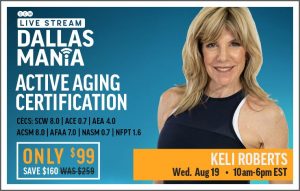 Our Active Aging Population
Our Active Aging Population
Many methods for categorizing individuals over age 50 exist today. A researcher by the name of Spirduso has expanded on the categorization above and divided those individuals of age into five major groups:
Level 1 – Healthy: No major medical concerns; in relatively good condition for age; has exercised for the past several years
Level 2 – Ambulatory/Non-active: No major medical concerns; has never participated in a structured exercise program
Level 3 – Ambulatory/Disease: Diagnosed as having severe coronary artery disease, arthritis, diabetes or chronic obstructive
pulmonary disease
Level 4 – Frail Elderly: Relies on partial assistance from professional staff for Activities of Daily Living; can stand or walk short
distances (usually less than 100 feet) with an assistive device; spends most of the day sitting
Level 5 – Wheelchair-Dependent: Relies on total assistance from professional staff for Activities of Daily Living; cannot stand or walk
Active Aging Teaching Techniques
To be effective communicators with Active Agers, we will want to adopt a nomenclature or language that produces the most pleasant and effective results in the least amount of time. Please consider the following suggestions:
- We should dress in a way that proves conducive to earning the respect of Active Agers. We want to teach in a way that Active Agers want to be spoken to, which is on a level of equality, respect and understanding despite any difference in age among them or between the instructor and them. Clothing that is both appropriate to the session, as well as respectful of the Active Ager means:
- Avoid showing excessive amounts of skin
- Avoid choosing darker colors, but instead using brighter colors to enable those with vision disabilities to see movements easily
- Show respect while simultaneously creating a cheerful environment
- Consider placing your participants in semicircles when possible since this allows better visual access for all and creates a “family style” team feeling of camaraderie amongst everyone.
- Teach the session from various positions on the deck, which will allow you to build an exciting amount of group dynamics, gives you visual access to view participants at different angles and assures you will be closer to different students at different times, which can instill a feeling of safety with your participants.
- When deciding how to break down movements for participants, you will often have to choose between demonstrating with the legs or arms first. In many instances, instructors begin with the legs moving and then offer additional movements involving the upper body. You may wish to start with the easiest common denominator for many, which often includes the arms first because most people have fewer inhibiting conditions with the arms versus the legs.
- When you face the class and perform movements on the same side of the body as participants, you are cueing towards their orientation or mirror imaging. This is advantageous because it is easier for participants to hear and follow the instructor. You can perfect this skill by practicing in front of a mirror.
 It is our hope that this article has provided you with information that will enable you to better understand categories of Active Agers and how various teaching tips can assist you with creating a more successful session and learning environment.
It is our hope that this article has provided you with information that will enable you to better understand categories of Active Agers and how various teaching tips can assist you with creating a more successful session and learning environment.
Please remember that “In the end, it’s not the years in your life that count. It’s the life in your years!”
To learn more about working with the Active Aging population, SCW Fitness Education offers certifications in both Active Aging and Active Aging Nutrition as well as Functional Flexibility and Aquatic Exercise. For more information for both online and Live Stream Certifications, visit www.scwfit.com/LiveStream. Also be sure to check out the upcoming SCW Live Streaming Dallas MANIA®, Aug 21-23 for workshops with Ann Gilbert and many others well known presenters offering workshops ranging from Group Exercise to Aqua and Active Aging to Business.
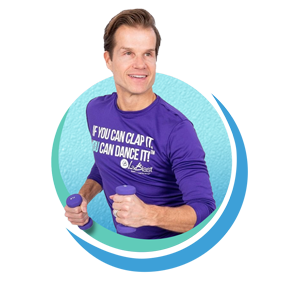
Keep It Simple, Use Your Hands, and be Logical…
Lessons I’ve Learned as a LaBlast® Master Trainer
by Megan Cooperman
Like many other fitness instructors, I began teaching while in college. As a land fitness instructor and regular aqua class participant, I was offered free in-house aqua fitness instructor training (if ever offered free training, take it, there is always something to be learned).
I was the instructor who over choreographed and over planned my classes, spending excessive time and energy preparing to teach a high-quality class. While those attributes are not wrong, I was using many more hours preparing versus what I was getting paid for. Time is value and while money is not the only reason I teach, I want the use of my time to be financially valuable as well.
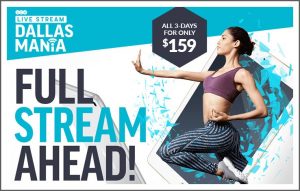 In 2016, I started working with Louis Van Amstel, the creator of LaBlast® and LaBlast® Splash. His guidance has taught me valuable teaching skills, helping me grow in every format I teach (12 classes a week, multiple formats). Louis, a World Ballroom Dance Champion, incorporates his extensive ballroom knowledge and years of experience, in his teaching and fitness programs. This education has not only helped me become a more efficient instructor but has also showed me how to balance my time, focus, and overall energy toward group fitness.
In 2016, I started working with Louis Van Amstel, the creator of LaBlast® and LaBlast® Splash. His guidance has taught me valuable teaching skills, helping me grow in every format I teach (12 classes a week, multiple formats). Louis, a World Ballroom Dance Champion, incorporates his extensive ballroom knowledge and years of experience, in his teaching and fitness programs. This education has not only helped me become a more efficient instructor but has also showed me how to balance my time, focus, and overall energy toward group fitness.
Louis encourages three main principles, applicable to all class formats.
Keep It Simple, Less Is More
LaBlast® encourages simplicity. Louis keeps movements simple while adding layers of dynamics or focus. Doing one move various ways allows an instructor to do so much, with less thought and extensive hours of practice. Dynamics are clear intentions and focus of your movement. For example, if instructing a pendulum in the pool, there are many ways to teach it, arms (short or long levers), legs (various levels), speeds (aqua speed/land speed), counts (singles/ doubles), etc. In LaBlast®, I use that movement, which is a common Quickstep pattern, quite often. While teaching a pendulum, my first dynamic or intention is to focus on the true ballroom move. I keep my arms up in ballroom hold and make my knees stay soft, as though I am dancing with a partner (I encourage you to try this, it is hard and requires your core engaged). Following this I can then opt to change the dynamic of the pendulum and focus on “fitness” intensity and force. I safely bring my arms back in the water and add assisted long lever arms pushing the water with strength and intensity. These are two different dynamics or intentions of the pendulum movement. Even though they are small changes, members are kept mentally engaged and physically working hard with minimal effort on my part as the instructor.
Use Your Hand Positions in LaBlast® Splash, correct use of the hand positions is strongly encouraged and highly recommended. Many aqua fitness instructors learn these positions in their first aqua fitness instructor training and forget to use them. Adjusting hand positions allows you to teach smarter and with less effort. Here are the recommended hand positions:
- Cups
- Claws
- Fists
- Palms
- Flat
Do you use them regularly in your classes? It is such a simple thing to add and requires little thought on your part. Take one aqua fitness move and add various hand positions, see how simple it is to change the class without doing a lot of work on your part.
Make it logical
Louis is a firm believer of keeping your classes logical. He tells instructors to identify how many repetitions of a pattern (move) are wanted to keep it clear for members. In LaBlast® Splash and LaBlast® Fitness we recommend that instructors primarily use patterns, this provides minimal choreography time.
 As a busy fitness instructor, mother of teens, full time group fitness manager, and more, I have limited time to memorize or create my own choreography. My life is much easier using patterns. I do not memorize choreography. I use LaBlast® ballroom patterns to any type of music, assuming the rhythms match the style of dance and patterns I am using; I can easily switch a song in my classes at any time. If a member asks me for their favorite song, I can pull it out that day and use it, even if I have never heard it, no need to go home and choreograph. Once I learned how to do this in LaBlast®, I incorporated it in other classes like shallow aqua fitness, land barre, and toning classes. I know what movements and patterns I want to use in those formats, I keep it logical and use the same repetitions of movements. This makes teaching so much easier. It is a refreshing change after years of taking extensive time to memorize choreography. As a plus, members do not know the difference, many think I am using choreography.
As a busy fitness instructor, mother of teens, full time group fitness manager, and more, I have limited time to memorize or create my own choreography. My life is much easier using patterns. I do not memorize choreography. I use LaBlast® ballroom patterns to any type of music, assuming the rhythms match the style of dance and patterns I am using; I can easily switch a song in my classes at any time. If a member asks me for their favorite song, I can pull it out that day and use it, even if I have never heard it, no need to go home and choreograph. Once I learned how to do this in LaBlast®, I incorporated it in other classes like shallow aqua fitness, land barre, and toning classes. I know what movements and patterns I want to use in those formats, I keep it logical and use the same repetitions of movements. This makes teaching so much easier. It is a refreshing change after years of taking extensive time to memorize choreography. As a plus, members do not know the difference, many think I am using choreography.
If you don’t believe me, I invite you to take a LaBlast® Splash or LaBlast® Fitness class at the upcoming SCW Live Streaming Dallas MANIA®, Aug 21-23. Join Louis Van Amstel for classes like “Making Waves with LaBlast® Splash” and “Waltz, Tango, Foxtrot”.
Just an additional note, with the situation we are all facing, Louis is offering all his live virtual classes FREE. For more information, visit the LaBlast® website.
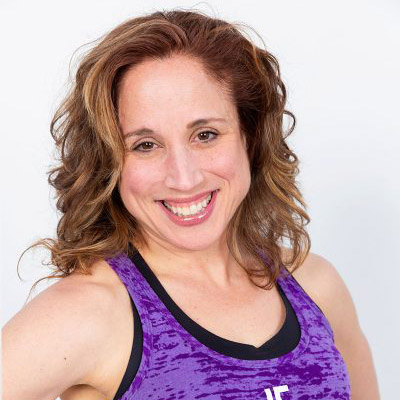 About the Author, Megan Cooperman
About the Author, Megan Cooperman
Megan Cooperman is a LaBlast® Splash and Fitness Master Trainer. She works full-time as a group fitness manager at a large non-profit residential association in Columbia, Maryland. She has a master’s degree in Counseling from the University of Maryland, and in her free time loves to see Broadway shows.
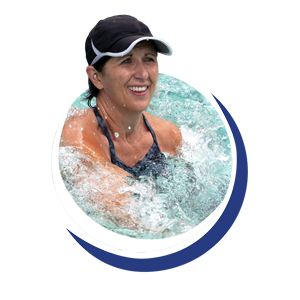
Aqua Aerobics: Exercise For All
by Robin Taylor
Picture this, it’s pushing 90 degrees and you actually feel like exercising, but you know any outdoor workout is out of the question. You remember the pools just opened, the lightbulb in your brain goes on, aqua aerobics! You ask your BFF to join you in a class and they just laugh and say, “Why do you want to do that? It’s for old people.”
 That was so yesterday, the scene of bathing caps and swim ruffles is long gone. Today aquatic fitness has done a complete 180. Classes are popping up everywhere and they are nothing like they used to be. Aquatic Fitness Instructors are becoming certified to teach all types of water workouts. The basic “freestyle” class is being joined with programs and styles like Tabata, Barre, Yoga, Tai Chi, HIIT and WATERinMOTION® just to name a few.
That was so yesterday, the scene of bathing caps and swim ruffles is long gone. Today aquatic fitness has done a complete 180. Classes are popping up everywhere and they are nothing like they used to be. Aquatic Fitness Instructors are becoming certified to teach all types of water workouts. The basic “freestyle” class is being joined with programs and styles like Tabata, Barre, Yoga, Tai Chi, HIIT and WATERinMOTION® just to name a few.
Most people have no idea what the benefits of aquatic exercise are. Each style provides different benefits, but here are some of the top reasons why it should be incorporated into your weekly workout regimen.
Increase Muscle Strength
Working out in the water provides 12 times more resistance than air. Water surrounds the arms and legs creating opposition from all directions. The addition of equipment, both buoyant and drag adds to the challenge. With that being said, the muscles have to work harder to move through the water which leads to increased muscle strength. WATERinMOTION® has released their latest format, WATERinMOTION® Strength. It includes the use of aqua dumbbells throughout the entire workout fatiguing, yet fortifying the muscles in the arms, legs and core.
Low-Impact Exercise & Less Stress on the Joints
When exercising in a pool, buoyancy takes over. As much as 90% of our body can be submerged, creating less stress in the joints and less of an impact when jumping or rebounding. The deeper the participant is submerged, the less stress in the joint.
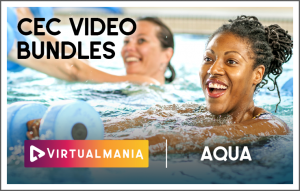 Cardiovascular Health & Chronic Illness
Cardiovascular Health & Chronic Illness
150 minutes of moderate-intensity aerobic activity per week can help decrease your risk of chronic illness, like arthritis according to the Centers for Disease Control and Prevention. The hydrostatic pressure and resistance of the water works with blood flow which can possibly decrease blood pressure and improve the resting heart rate which in turn could lower your risk of heart disease.
Cooling Body Core Temperature
You may not realize it, but we can sweat in the pool. Our body temperature stays cooler allowing us to work harder and longer due to the cooling effects of the water. Just because you don’t feel the sweat, doesn’t mean you don’t have to drink water. Most of us don’t realize we are thirsty until it is too late. When your throat feels dry, you are already feeling the effects of dehydration. Be sure to drink water throughout your workout. Go ahead and grab your water bottle.
Creates Social Bonding
As we all know, wellness centers and pools are a great way to meet people. The friendships made from attending aqua aerobics classes can extend beyond the pool. Social gatherings are common among water fitness enthusiasts. Some facilities even offer classes and programs which incorporate partner work. WATERinMOTION® includes a song in every release that involves group activities and movements. The exercises can be as simple as a high-five to as involved as individuals moving from small group to small group to increase social interaction.
Increase Flexibility, Balance and Range of Motion
The buoyancy of the water not only provides protection on the joints but allows the muscle to stretch which can help increase flexibility and range of motion. It also creates an unstable environment causing muscles in the back, abdominals and core to contract in order to stay upright and balanced.
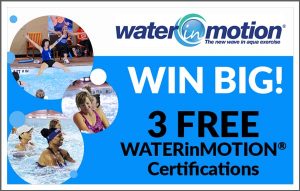 Relieves Stress and Anxiety
Relieves Stress and Anxiety
According to an article on the AARP website, pool time seems to improve mood and mental health. The “feel-good” emotions of completing a strenuous workout are often attributed to the release of endorphins, hormones that produce a “runner’s high”, which can result in positive psychological benefits.
Total Body Training
Last, but not least, aquatic fitness requires use of the whole body, even if the focus of a movement is only on one area. As mentioned above, the principle of buoyancy requires almost all the muscles in the body to work together in order to balance and move. Most water classes involve the use of both the arms and legs. Depending on the format, one area may supersede another, but as we have learned since we were children, “the foot bone connects to the ankle bone, the ankle bone is connected to the leg bone, etc.” This total body workout is perfect for all ages, abilities, athletic levels and physical requirements.
Even in this unsettled world in which we now live in, the CDC says there is no evidence that COVID-19 can spread to people through the pool. They do recommend social distancing and wearing a mask when possible. So the next time you ask your BFF “Do you want to take an aqua aerobics class?”, also add the facts that you can get stronger, create less impact on your joints, keep cool even though you are sweating, make new friends, become more flexible, reduce stress and get a complete total body workout. Grab your towel, water bottle, sunscreen and favorite pair of shades. Bathing caps optional!
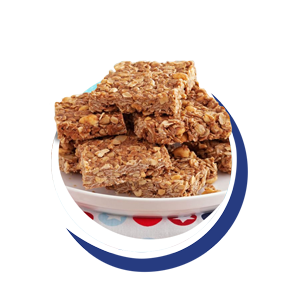
Chocolate-Peanut Granola Bars
Nutella and peanut butter meet to make some amazing granola bars. Your family will think they’re eating something naughty, but the bars are full of oats and healthy fats. They’re just perfect to grab and go!
 Ingredients
Ingredients
2-1/2 cups old-fashioned oats
3/4 cup lightly salted dry roasted peanuts, coarsely chopped
3/4 cup wheat germ
3/4 cup sunflower kernels
1/2 cup honey
1/4 cup packed brown sugar
3 tablespoons butter
1/3 cup creamy peanut butter
1/3 cup Nutella
Directions
1. Preheat oven to 400°. In an ungreased 15 x 10 x 1-in. baking pan, combine oats, peanuts, wheat germ and sunflower kernels. Bake, stirring occasionally, until toasted, 8-12 minutes. Cool in pan on a wire rack.
2. In a small saucepan, combine honey, brown sugar and butter. Cook and stir over medium heat until mixture comes to a boil; cook 2 minutes longer. Remove from heat; stir in peanut butter and Nutella until blended.
3. Transfer oat mixture to a large bowl; add honey mixture and toss to coat. Press into a greased 13×9-in. pan. Cool. Cut into bars.
Nutrition Facts
1 bar: 178 calories, 10g fat (2g saturated fat), 4mg cholesterol, 75mg sodium, 20g carbohydrate (11g sugars, 2g fiber), 5g protein.

SCW Live Streaming Dallas MANIA® $100 OFF
(
Learn More

SCW Live Streaming Certifications $100 OFF
(
Choose Your Cert Here

SCW Online Certifications $50 OFF
Choose Cert & Use Code: CERT50

$50 OFF 20 CEC Video Course Bundles
(Was $139, Now $89) or (Was $209, Now $159)
Choose Bundle & Use Code: VIRTUAL50

Online CEC Courses $10 OFF
(
Choose Courses & Use Code: CEC10

Save $20 SCW OnDemand
Subscribe & Use Code: ONDEMAND20

20% OFF SCW Digital Videos
Choose Videos & Use Code: VIDEO20

50% OFF Home Equipment Must-Haves
Shop the 50% Sale Here

FREE Upcoming Webinars From SCW
Register FREE Here
